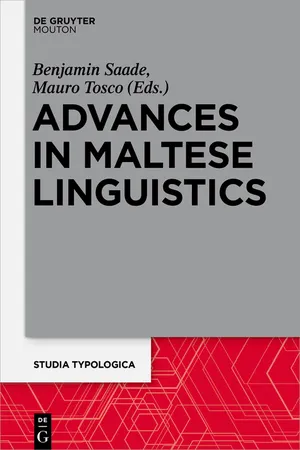On the phonology of Sicilian Arabic and early Maltese
Abstract: The existence of a historical-linguistic relationship between Maltese and Sicilian Arabic is generally accepted, although its exact nature is a matter of some debate. The paper examines the available evidence and compares a number of developments attested in the phonology of Sicilian Arabic and early Maltese. The issues covered include: word-medial and word-final imāla, the nature of “secondary”/“auxiliary” vowels, vowel harmony, the fate of the Arabic marked phonemes (e.g. the interdental and “emphatic” consonants), and obstruent devoicing. The findings are discussed in terms of their relevance to the hypothesis positing that Maltese is a descendant of Sicilian Arabic.
Keywords: Sicilian Arabic, Maltese, phonology, peripheral features
1Introduction
Sicilian Arabic and Maltese have long been thought to be connected. According to Isserlin (1977: 20), for instance, “that the Arabic of Sicily should have been related to the language spoken in Medieval Malta […] is a natural assumption”. What is less “natural” and consequently less commonly agreed upon is the exact nature of the historical-linguistic relationship holding between these two varieties of Arabic.
The linguistic complexities involved are compounded by controversies surrounding the history of Malta in the wake of the Arab invasion. One view is found in Brincat (1995), who analyzes an Arab historian’s account of two key events. According to Al-Ḥimyarī, after the Arab invasion in 870 “the island of Malta remained an uninhabited ruin” at first, but later, “after the year 440 AH [= 1049–1049] the Muslims peopled [Malta]”. Brincat (1995: 22) admits that “whether the community which settled in Malta came from Southern Italy (Apulia?) or Sicily is difficult to establish, due to the lack of written evidence” and states that one should therefore turn to linguistic evidence. While advocating “a thorough comparative investigation” of Sicilian Arabic and Maltese, Brincat (1995: 22) explicitly mentions “the impression that Maltese has stronger contacts with Sicilian Arabic than with any other Arabic dialect”. The “impression” is supported by the categorically formulated conclusion that “the historical and geographical factors now decidedly point to Sicilian Arabic as the basic source of the Maltese language” (Brincat 1995: 27).
A different view is outlined by Agius (1996b: 432), according to whom “during the twelfth century Siculo-Christians from Sicily […] populated the Maltese islands as part of the Norman expansionist policy”. Although premised on an immigration flow taking place at a later date and involving a different population group, Agius (1996b: 432) reaches a similar conclusion with respect to the origin of the Maltese language: “Maltese […] is directly linked with the Siculo-Arabic and not with North African dialects”.
The aim of the paper is to compare a number of selected phonological features of Sicilian Arabic and early Maltese with a view to evaluating the results in terms of their compatibility with the views according to which Maltese is a direct descendant of (varieties of) Sicilian Arabic. The working hypothesis is that well-established phonological features or at least tendencies already attested in Sicilian Arabic should also be identified in the earliest records of Maltese. Their identification in early Maltese rules out the potential effect of later developments, internal or contact-induced, in the phonology of Maltese.
The paper is structured as follows. Section 2 briefly discusses the nature of the currently available data of Sicilian Arabic and early Maltese. Section 3 is concerned with vowels. Section 4 focuses on consonants. Section 5 summarizes the findings and assesses their implications.
2Data
Researchers voice radically different opinions as to the study of Sicilian Arabic. Metcalfe (2003), for instance, writes that reconstructing Sicilian A...

